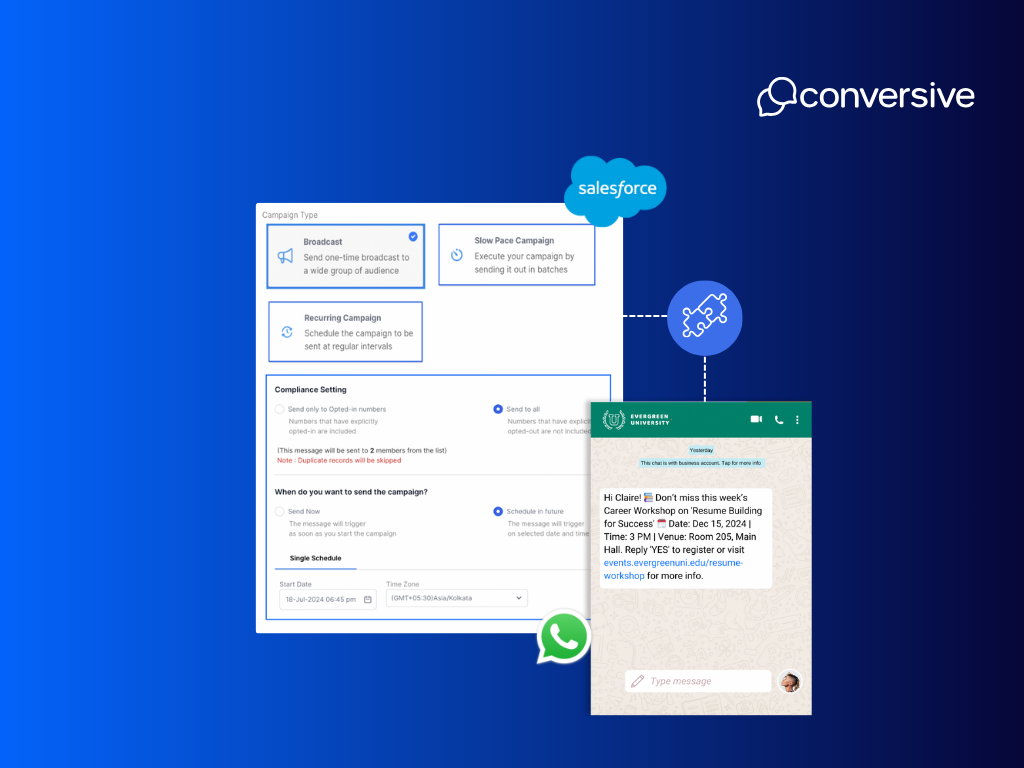
How AI Is Humanizing Customer Experience in 2025
In 2025, AI powers hyper-personalized, emotion-aware CX. Discover 10 trends transforming support into smart, seamless, and human-like experiences, at scale.
In 2025, AI is doing more than just help chatbots talk, it will change how companies understand and respond to customers' feelings, customize their services, and improve how they run their businesses, which means, everything will move around - customer experience (CX), in fact 89% of businesses compete primarily on CX, and not price or product.
Customer expectations have skyrocketed, 79% of consumers demand faster, more personalized service, while 80% of customers say the experience a company provides is as important as its products and services.
Companies that are still sticking to old ways of providing customer service, won't keep up with how people now interact digitally. As Satya Nadella points out,
“computers don’t give a damn. But we do” .
So, it's important to make AI customer service feel more human by teaching it to recognize emotions, understand the context, and know when to hand things over to real people.
By the time, you’d finish reading this playbook, you’ll walk away with:
- A crystal-clear vision of the future of AI in CX
- The top AI CX trends shaping brands today
- Real-world, measurable use cases from industry leaders
- An actionable playbook to integrate AI without losing the human touch
In a nutshell, you’ll know which AI-driven strategies can truly elevate your CX, making customers feel heard, valued, and delighted at every interaction, so let’s get started!

AI is the Backbone of Modern CX
Many companies used to think of AIs as add-ons they could just add to their existing customer service tools. But now, that way of thinking is no longer valid. AI has become the main foundation for creating and improving customer experiences. It’s now central to how businesses communicate, understand customer feelings, analyze data, and respond. AI now permeates every layer of interaction be it insight, or action.
Here’s how it powers the full spectrum:
LLMs and NLP Engines: The Brains Behind Chatbots and Digital Agents
Large Language Models, such as GPT or Claude, do more than just answer simple questions. They can hold detailed conversations, respond in a caring way, and work through complex requests. They are used in things like email, chat apps, and voice assistants.
For example, Alexa and Google Assistant use a technology called Natural Language Processing to understand what you're asking, figure out what you mean, and keep track of the conversation so they can respond appropriately, making the interaction feel more natural and human-like.
75% of consumers who have already used generative AI think it will change their customer service experiences in the near future. While, 70% of CX leaders think generative AI makes every digital customer interaction more efficient.
Emotion AI & Sentiment Engines: Reading Between the Lines
Emotion AI tools, like Cogito or Affectiva, can read things like how someone talks, how fast they speak, the feelings behind their words, and tiny facial expressions in videos. Companies use this to figure out if a customer is feeling worried, angry, confused, or bored. If they sense someone is upset during a call, like in a phone support situation, the system can immediately notify a supervisor. That way, the company can try to calm the customer or fix the problem right away, instead of waiting for a negative survey later.
Sentiment analytics is part of a broader shift, speech analytics reached 44% adoption in 2024, and is also projected to hit 84% in the next two years, highlighting growing investment in real-time voice analysis and automation. (Market.us Scoop)
AI-Powered Co-Pilot Dashboards: The Force-Multiplier for Agents
There’s a popular misconception that AI exists to replace human agents. But in reality, the most forward-thinking companies are using AI to supercharge human potential, not sideline it.
Take Comcast, for example, a brand managing millions of interactions daily. They’ve implemented LLM-powered co-pilot tools that seamlessly integrate “Ask Me Anything (AMA)” functionality right into agent dashboards. These intelligent copilots don’t just fetch policy documents or FAQs, they also analyze conversation context, auto-fill resolution steps, and even suggest next-best actions mid-call, drawing from vast internal knowledge bases in real-time.
They reported a 10% increase in resolution speed and multibillion-dollar operational efficiencies, according to an LLM study published on arXiv. In high-volume environments, that’s not just optimization, it’s transformation.
This is the power of AI when positioned as an assistant, not a replacement. It helps agents spend less time hunting for answers and more time connecting with customers.
AI as the CX Nervous System: The Silent Operator Behind Seamless Journeys
If customer experience were the body of your business, then AI is its nervous system. Just as nerves sense things happening in the body and send signals to react, AI constantly monitors what’s happening with customers online and through interactions. It can notice things like the tone of a customer’s voice, their browsing history, or if they seem unsure.
Then, using smart tools like predictive models and language programs, AI makes sense of this information, figuring out what it means. Based on that understanding, it responds by offering help, connecting the customer with a human if needed, or customizing what the customer sees or experiences right away.
Basically, AI acts like a nervous system that coordinates all the data and interactions, be it through chat, email, phone calls, mobile apps, or social media, thus, allowing a business to not just react when something is wrong, but to anticipate what customers might need and guide them proactively. Statistically, 85% of CX Touchpoints are now influenced by AI alone.

10 AI CX Trends You Can’t Ignore
With AI now deeply embedded as the nervous system of CX, the next wave is all about how these technologies evolve and expand. From smarter conversations to autonomous journeys, AI is shaping the future of CX in ways that can’t be ignored. Here are 10 AI-driven trends that are redefining how businesses connect, engage, and delight customers today, and tomorrow.
1. Generative AI for Conversations
By the end of 2025, AI will handle up to 95% of customer interactions, with a projected 30% boost in customer satisfaction all due to more intelligent & empathetic bots.
Generative AI, like GPT-4, Claude, and Gemini, are smart assistants that can understand and respond to questions or tasks. They can help answer complicated questions, create articles, and keep track of what you're saying over long conversations. These AI models can chat naturally, adjust to what you need, and understand the context of your interactions.
Use Case: A customer contacts an online store and asks, “Can you help me find a running shoe that fits wide feet and is good for trail running?”. The AI assistant understands the specific needs, recommends a pair of wide-fit trail running shoes, explains their features, and even suggests compatible socks, all while remembering that the customer previously asked about athletic footwear.
Pro Tip: Don’t just automate FAQs, use generative AI to handle nuanced queries and offer context-aware escalation to live agents when needed.
2. Emotion AI & Sentiment Analysis
AI can now listen and watch how someone speaks, like their speed, the words they use, and even pauses, to figure out how they’re feeling, such as angry or confused. This helps companies step in early if someone is upset or frustrated.
Use Case: Contact centers using emotion analytics have achieved up to a 25% improvement in customer retention, in part by proactively managing emotionally charged calls and minimizing customer churn. And 21% to 27% improvement in key customer experience KPIs. (Convin.ai)
Pro Tip: Integrate sentiment scoring into both bot and agent workflows. If confidence drops below a threshold, route to human agents with a full emotional history.
3. Voice & Conversational AI
Voice interfaces are becoming more common because of improvements in natural language processing (NLP). Among companies utilizing AI bots, 46% employ them for voice-to-text dictation.
Gartner forecasts that conversational AI will reduce contact center agent labor costs by a staggering $80 billion by 2026. And 90% of businesses witnessed faster complaint resolution due to bots. For these systems to work well, they need to transfer conversations smoothly between automated bots and human agents.
Use Case: Voice bots that use AI in the telecom industry can handle between 60% - 85% of basic customer questions, like billing, plan details, or adding more data, without needing a human person to step in. When these systems are set up really well, they can automatically deal with about 80% of common questions, which means human agents only have to handle the complex issues.
Pro Tip: Focus on intent recognition and fallback handling. If voice bots detect uncertainty or negative sentiment, hand off quickly, with full conversation history.
4. Agentic AI: From Co-Pilot to Autopilot
AI tools are getting better and more independent. Instead of just giving advice or suggestions, they can now make decisions and take actions on their own.
Use Case: In the healthcare domain, AI isn't just enhancing customer experience, it’s saving lives by improving both speed and accuracy in diagnostics. AI-powered imaging systems (in radiology) have achieved up to 97% accuracy in identifying certain abnormalities, outperforming the 86% accuracy rate of human radiologists in some clinical studies.
Accuracy is just one part of the story, these systems also reduce image analysis time by an average of 75%, allowing radiologists to see more patients, shorten diagnostic cycles, and cut down long wait times in overburdened clinics. (Super AGI)
Pro Tip: Define clear decision boundaries. Let AI act autonomously within low-risk areas, and use co-pilot mode for high-stakes issues.
5. Hyper-Personalization & Predictive CX
Since, consumers expect brands to know what they need, not just reactively, but proactively. AI makes this possible by analyzing vast amounts of data in real time, including:
- Browsing and purchase history
- Geolocation and device data
- Stated preferences and inferred emotions
- Contextual triggers like time of day or weather
By gathering lots of different behaviors and signals, a system can tailor its responses and suggestions in a very personalized way. McKinsey reports, personalization can reduce customer acquisition costs by as much as 50%, lift revenues by 5% to 15%, and increase marketing ROI by 10% to 30%.
Use Case: An online shopping site might suggest buying a raincoat right when bad weather starts in your area, or it might change how it talks to you if it notices you're upset or annoyed based on how you're expressing yourself.
Pro Tip: Use AI to create dynamic segments that evolve daily based on behavior, not static traits like age or region.
6. Autonomous Customer Journeys
We're maneuvering in an era where customer service is mostly handled by AI, obviously with a personal and caring touch. Many support tasks happen on their own quickly and accurately. Let’s say, a return request triggers AI-led workflows, eventually, a courier is scheduled, the refund is processed, and a discount for future purchase is offered, all with zero human intervention.
Businesses using AI for customer service have achieved a 40% reduction in handle time, a 35% drop in escalations, and a 30% boost in agent productivity, driving customer satisfaction scores to over 99%. (Stratosphere Networks)
Use Case: H&M exemplifies how this seamless, AI-enhanced experience translates into real-world success. A typical customer journey would be, a shopper discovers a trending outfit on Instagram, uses the H&M app to check in-store availability, tries it on with the help of a smart mirror that suggests alternatives, and completes the purchase via self-checkout. If a return is needed, the process is streamlined with in-app options and in-store drop-offs. Along the way, the customer earns loyalty points, receives personalized offers, and shares their look through integrated social features, all powered by a tech-driven, customer-first strategy that fosters engagement, retention, and advocacy.
Pro Tip: Start with repetitive, rules-based journeys (returns, billing issues, password resets), then layer AI decision-making for upselling and proactive recovery.
7. AI-Human Hybrid Workforce
The future of CX isn’t just choosing between AI and people. It’s about giving people tools powered by AI so they can do their jobs better, like building relationships, understanding customers’ feelings, and solving problems.
AI handles the boring, repetitive stuff, like quickly finding customer information, recommending what to do next, or summarizing conversations, so human workers can focus on the parts that require understanding emotions, thinking creatively, and handling tricky situations that machines aren’t good at.
75% of CX leaders see AI as a force for amplifying human intelligence, not replacing it, while 80% of employees say AI has already helped improve the quality of their work. (Zendesk).
Use Case: A customer calls a support center about a delayed order. The AI quickly retrieves the customer's purchase history and suggests troubleshooting steps. The human agent uses this information to empathize with the customer's frustration and offers a personalized apology, then works creatively to find a solution.
Pro Tip: Use AI to coach agents in real time, suggesting responses, tone adjustments, and knowledge articles, especially during onboarding.
8. Privacy-Aware Personalization
Personalization without privacy is a red flag. Nearly, 55% of consumers say trustworthiness and transparency are the most important traits of a brand, and 71% of consumers surveyed want brands to proactively disclose how generative AI is used in products and services, not just reactively respond to inquiries.
New AI tools help companies customize what they offer to customers without using personal details. Instead, they use fake or anonymized data to keep people's privacy safe. This also helps companies follow laws that protect personal information, like GDPR and CCPA. Overall, it keeps customer privacy secure and maintains the company's good reputation.
Use Case: Spotify leverages AI-powered synthetic data generation to personalize music recommendations without exposing real user data. Instead of analyzing individual listening histories directly, the AI models train on anonymized, simulated data that mimics user preferences and behaviors.
Pro Tip: Make your AI’s role visible and optional, clearly indicate when customers are interacting with bots and allow them to opt out of data personalization.
9. Synthetic Data for Training & Simulation
AI models need lots of information to learn from, but using real customer data can be risky because it might reveal private details. Synthetic data is fake data made by AI that mimics real information. It helps teams train their systems and run tests without risking people's private info.
Industries like banking, healthcare, and telecom are using synthetic data more and more to speed up their AI projects while still protecting people's privacy.
Use Case: A bank creates a synthetic dataset of fake customer information, including names, ages, account balances, and transaction histories. The team uses this data to train their fraud detection AI system, testing how well it identifies suspicious activity without risking any real customer details.
Pro Tip: Use synthetic data to fine-tune NLP models and create robust AI responses, even for rare edge cases.
10. Security & AI-Powered Threat Detection
As AI is used more to improve CX systems, it also helps protect them. AI can spot fake voices or hacked accounts, find unusual activity, and make sure rules are followed, all instantly. It keeps an eye on how people behave over time to catch sneaky fraud attempts or anything that breaks rules before it becomes a bigger problem.
AI-driven behavioral monitoring can detect and prevent up to 95% of fraudulent transactions when paired with behavioral biometrics and cross-session pattern analysis.
Use Case: A bank uses AI to monitor customer transactions in real-time. If someone tries to make a large purchase using a stolen credit card, the AI notices that this transaction doesn't match the customer's usual spending patterns, such as location, amount, and device used. The AI then flags the activity immediately, temporarily blocks the transaction, and alerts the customer to verify if it's legitimate, preventing potential fraud before any damage is done.
Pro Tip: Integrate fraud detection and sentiment analysis into the same workflow. Emotional signals can indicate deception as well as dissatisfaction.

Ethics, Regulation & Trust: The Foundation of Responsible AI in CX
In customer service, doing what's right isn't just a nice idea, it's the foundation everything is built on. Issues like unfairness in AI, being open about how things work, and getting permission are essential for people to trust and feel comfortable with how they're treated.
When customers are aware that AI is being used, especially in high-stakes or sensitive situations, they respond better. As per the recent study by BusinessWire, 62% of consumers would trust brands more if they were transparent about AI use. The same report suggests that 84% would have more trust in AI that demonstrates explainability, that is, AI which seeks to be transparent and understandable to humans.
So how do you design ethical AI in CX?
Transparency First
Let customers know when they’re interacting with AI, especially in chats, voice, or automated emails. Hidden automation erodes trust.
Explainability Matters
Ensure customers and agents can understand why AI made a suggestion or decision. Black-box models damage credibility.
Human Handoff
Always offer a smooth way to escalate from AI to a human. Empower customers to choose how they engage.
Interaction Logging
Maintain audit trails of AI decisions and interactions. This is crucial in regulated sectors like finance or healthcare.
Consent by Design
Get clear, upfront permission when using personal data for AI personalization. Offer opt-outs where possible to respect autonomy.
Following these guidelines helps keep your brand safe from legal problems and reputational risk. It also helps build customer loyalty over time. As technology like AI becomes more common, successful brands will be the ones that avoid unexpected actions and instead focus on giving customers control and positive experiences.
What Happens When You Put Conversive at the Heart of Your Customer Experience?
With features like those offered by Conversive, you get more than just AI—you get real connection. From reading emotions to predicting intent, today’s AI can deliver empathy, speed, and personalization at scale. But only if you use it right. Conversive makes that easy. Here’s how:
1. Generative AI for Conversations
- Empathetic AI agents powered by LLMs (GPT, Claude, Gemini, etc.)
- Understand complex queries, retain context across interactions
- Deliver fluent, brand-safe, and human-sounding conversations
2. Emotion AI & Sentiment Analysis
- Real-time emotional analysis during conversations (text or voice)
- Automatically adapts tone or triggers human handover
- Visual sentiment dashboards for supervisors to intervene proactively
3. Voice & Conversational AI
- AI-powered voice bots with NLP for call centers and IVRs
- Accurate transcription, real-time voice tone analysis, and summarization
4. Agentic AI (Co-Pilot to Autopilot)
- Proactive suggestions, answer recommendation, and action automation
- Autopilot mode for low-risk queries (refunds, delivery status, form-fills)
5. Predictive & Hyper-Personalization
- Dynamic customer segmentation based on behavior, context, and emotion
- Real-time prediction of next-best action, product, or resolution
- Personalized recommendations across channels (chat, email, WhatsApp)
6. Autonomous Customer Journeys
- No-touch automation for returns, billing disputes, and onboarding
- Multi-step workflows powered by AI triggers and customer behavior
- Integrated across channels for consistent customer experience
7. Privacy-Aware Personalization
- Uses anonymized and synthetic data to power personalization
- Gives customers control over how their data is used
- GDPR, CCPA, and industry-specific compliance baked into design
8. Security & AI-Powered Fraud Detection
- Real-time behavioral analysis to spot fraud or unusual activity
- Integrated voice biometrics, anomaly detection, and escalation workflows
So, are you ready to build AI-powered experiences your customers will love, and trust? [Get a demo today.]
Frequently Asked Questions
1. What’s the #1 CX battleground in 2025?
Customer experience, not price or product, is where 89% of businesses compete today.
2. How is AI transforming customer support?
AI now acts as the nervous system of CX, powering everything from insights to actions.
3. Can AI understand customer emotions?
Yes. Emotion AI and sentiment tools detect tone, pace, and intent to respond empathetically.
4. Will AI replace human agents?
No, leading brands use AI as a co-pilot to enhance, not replace, human service.
5. How does predictive AI personalize CX?
By analyzing behavior, context, and emotion to proactively tailor customer journeys.
6. What’s an example of autonomous CX in action?
H&M’s AI-led journey, from social discovery to in-store smart mirrors, is fully seamless.
7. How can companies personalize without violating privacy?
With anonymized or synthetic data, staying compliant with GDPR and CCPA is achievable.
8. What makes ethical AI essential?
Trust. Transparency, explainability, and consent build lasting customer confidence.




